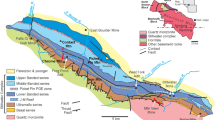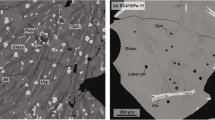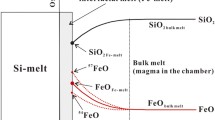Abstract
Incompatible trace-element abundances in minerals and whole rocks from layered intrusions have been used to model the fractionation processes and evolving liquid compositions. Many such models assume that the analyzed concentration in a mineral represents that of the mineral when it first crystallized. However, overgrowth from residual liquid and subsequent diffusive equilibration can result in significant changes to the bulk mineral compositions (the more incompatible the element the more dramatic the subsequent changes). The proportion of that residual liquid relative to the cumulus minerals is the most important parameter in determining the magnitude of this effect (trapped liquid shift effect). Calculations involving Ba and La contents in plagioclase quantitatively demonstrate this effect. For Ba and La (partition coefficients of 0.4 and 0.04), 50% trapped liquid in a sample can result in two and sevenfold increases, respectively, in concentration between original and final bulk mineral compositions. Different cumulus assemblages also have a major effect on final compositions. We use examples of the concentrations of Ba and La in plagioclase from the Skaergaard intrusion from previous publications to illustrate the importance of this effect. Specifically, the La content of bulk plagioclase steadily decreases upward from the Lower Zone to Upper Zone c, and Ba in plagioclase shows no increase from the Lower Zone to the top of the Middle Zone. Such results are not explicable by fractionation processes, but can be modeled by the trapped liquid shift effect, assuming the well-established evidence for upward decrease in trapped liquid proportion through these zones.



Similar content being viewed by others
References
Barnes SJ (1986) The effect of trapped liquid crystallization on cumulus mineral compositions in layered intrusions. Contrib Miner Pet 93:524–531
Bédard JH (1994) A procedure for calculating the equilibrium distribution of trace elements among the minerals in cumulate rocks, and the concentration of trace elements in the coexisting liquids. Chem Geol 118:143–153
Bédard JH (2006) Trace element partitioning in plagioclase feldspar. Geochim Cosmochim Acta 70:3717–3742
Blundy JD, Wood B (2003) Partitioning of trace elements between crystals and melts. Earth Planet Sci Lett 210:383–397
Cawthorn RG (1996a) Models for incompatible trace-element abundances in cumulus minerals and their application to plagioclase and pyroxene compositions in the Bushveld Complex. Contrib Miner Pet 123:109–115
Cawthorn RG (1996b) Re-evaluation of magma compositions and processes in the uppermost Critical Zone of the Bushveld Complex. Mineral Mag 60:131–148
Cawthorn RG (2013) REE abundances in apatite in the Bushveld Complex—a consequence of the trapped liquid shift effect. Geology 41:603–606
Godel B, Barnes S-J, Maier WD (2011) Parental magma composition inferred from in situ traceelements in cumulus and intercumulus silicate minerals; an example from the Lower and Lower Critical Zones of the Bushveld Complex, South Africa. Lithos 125:537–552
Hill E, Blundy JD, Wood BJ (2011) Clinopyroxene-melt trace-element partitioning and the development of a predictive model for HFSE and Sc. Contrib Miner Pet 161:423–438
Holness MB, Tegner C, Namur O, Pilbeam L (2015) The earliest history of the Skaergaard magma chamber: a textural and geochemical study of the Cambridge drill core. J Pet 56:1199–1227
Hunter RH (1996) Texture development in cumulate rocks. In: Cawthorn RG (ed) Layered intrusions. Elsevier, Amsterdam, pp 77–102
Jang YD, Naslund HR (2001) Major and trace element composition of Skaergaard plagioclase: geochemical evidence for changes in magma dynamics during the final stages of crystallization of the Skaergaard intrusion. Contrib Miner Pet 140:441–457
Lundgaard KL, Tegner C, Cawthorn RG, Kruger FJ, Wilson JR (2006) Trapped intercumulus liquid in the Main Zone of the eastern Bushveld Complex, South Africa. Contrib Miner Pet 151:352–369
McBirney AR (1996) The Skaergaard intrusion. In: Cawthorn RG (ed) Layered intrusions. Elsevier, Amsterdam, pp 147–180
McBirney AR (2002) The Skaergaard layered series. Part VI. Excluded trace elements. J Pet 43:535–556
Morse SA (1984) Cation diffusion in plagioclase feldspar. Science 27:1183–1214
Nielsen TFD (2004) The shape and volume of the Skaergaard intrusion, Greenland: implications for the mass balance and bulk composition. J Pet 45:507–530
Prowatke S, Klemme S (2006) Trace element partitioning between apatite and silicate melts. Geochim Cosmochim Acta 70:4513–4527
Rudge JF, Holness MB, Smith GC (2008) Quantitative textural analysis of packing of elongate crystals. Contrib Miner Pet 156:413–429
Tegner C, Thy P, Holness MG, Jakobsen JK, Lesher CE (2009) Differentiation and compaction in the Skaergaard intrusion. J Pet 50:813–841
Wager LR, Brown GM, Wadsworth WJ (1960) Types of igneous cumulate. J Pet 1:73–85
Acknowledgements
RGC acknowledges financial support from AngloPlatinum, Implats and Lonplats companies and NRF (South Africa). CT acknowledges funding from the Danish Council for Independent Research (Natural Sciences), the Carlsberg Foundation, and the Danish National Research Foundation. We thank Richard Naslund, Steven Barnes and Jonas Møller Pedersen for their comments and suggestions, and Christian Ballhaus for his editorial management.
Author information
Authors and Affiliations
Corresponding author
Additional information
Communicated by Chris Ballhaus.
Rights and permissions
About this article
Cite this article
Cawthorn, R.G., Tegner, C. Modeling incompatible trace-element abundances in plagioclase in the Skaergaard intrusion using the trapped liquid shift effect. Contrib Mineral Petrol 172, 93 (2017). https://doi.org/10.1007/s00410-017-1411-8
Received:
Accepted:
Published:
DOI: https://doi.org/10.1007/s00410-017-1411-8




